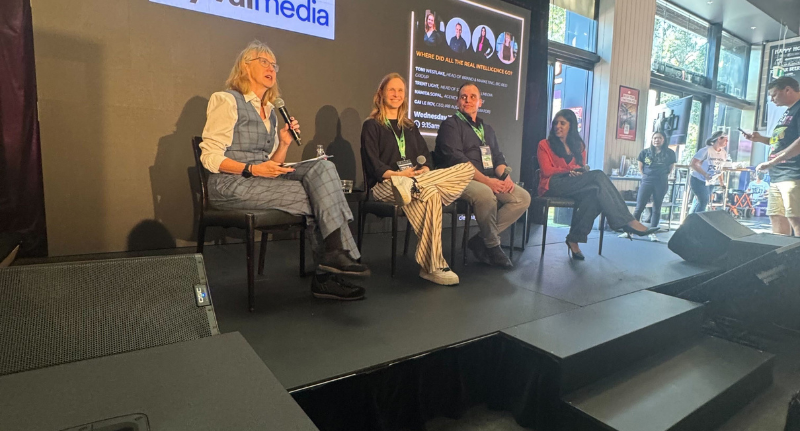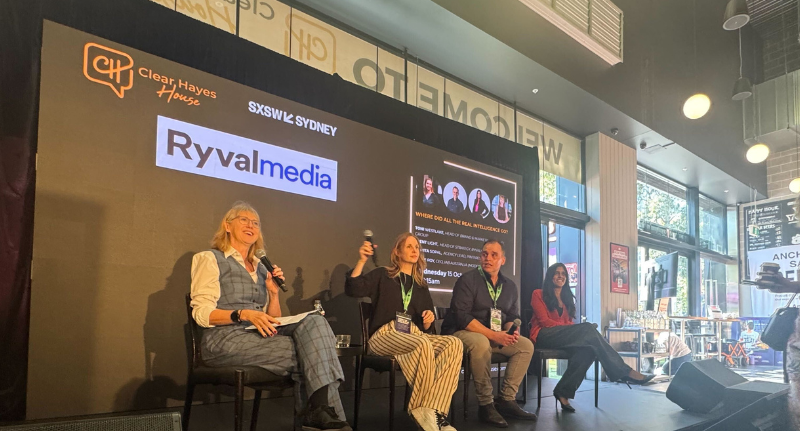Artificial Intelligence may be reshaping marketing faster than any technology in recent memory, but for a growing number of creative leaders, progress doesn’t mean removing every obstacle, it means putting some of them back.
At a SXSW Sydney panel discussion, Where Did All The Real Intelligence Go?, hosted by Ryvalmedia, marketing leaders from Big Red Group, Ryvalmedia, and Pinterest all landed on the same conclusion, friction, imperfection and curiosity, once seen as inefficiencies, are quickly becoming competitive advantages.
During the discussion, moderator Gai Le Roi from IAB, grilled Toni Westlake, Head of Brand and Marketing, at Big Red Group, Trent Light, Head of Strategy at Ryvalmedia and Namita Sopal, Agency Lead at Pinterest on how they use AI but critically how they ensure they get the very best from their team using it.

The human touch that AI can’t fake
Big Red Group’s CMO, Westlake, started the discussion by highlighting how she had learned a very hard lesson back in 2023 when the team ran a Christmas campaign fully generated by AI, and it failed spectacularly.
“We actually now have a rule that anything that touches the customer cannot be AI,” she said, explaining that she watched her CPC increase heavily in a campaign that was too perfect.
“We thought it was going to be a really great idea to do an AI generated campaign,” she said. “We actually had a real human but with a virtual production background that we wanted to create the feeling of the wonder of experiences as a gift for Christmas and so unsurprisingly, to probably everyone in this room, it didn’t work very well.
So what we saw, in terms of CPC was $1.28 and for us, for reference, the following Christmas, when we learned from all the mistakes, it went down to about 80 cents. Last Father’s Day it was closer to 20 cents.”
She explained that the work looked flawless but felt empty, “We realised it’s the imperfect moments, the hair in the face, the accidental snort when someone laughs, that make people feel something.”
“With our brand, it’s all about real human stories. It’s all about the connection that you get on those experiences. And weirdly, AI models looking absolutely perfect, staring glassily at you into the screen doesn’t really quite nail that.”
Now, Big Red Group does use AI for early-stage tasks like trend discovery, but not customer-facing content.
The lesson, Toni said, is that removing every creative constraint doesn’t make work better, it makes it forgettable.
AI can tell you what worked, but not why
For Ryvalmedia’s Trent Light, the risk isn’t just creative homogeneity, it’s intellectual laziness
“The tools are powerful,” he said. “But they only tell you what. They can’t tell you why.”
Light said he is now actively training teams to resist that automation trap. “We run hackathons where we don’t judge the output, we judge the thinking,” he said. “The tech is easy to implement. The harder thing is training people to ask better questions.”
He believes critical thinking, not just prompt engineering, will determine which agencies thrive in the next wave of AI adoption.
He also added Ryvalmedia place a real emphasis on remembering we are all customers, in a world of AI where we can rely on data for answers to briefs without using human instinct.
“I try and champion within the agency, this understanding that we are all also a consumer, ” he said. “And being able to test what you’re putting forward to the client.
“Most of us find ourselves in the target audience for most of the briefs that come through the door. When it comes to responding on a brief or finding insights, we seem to forget that we’re actually talking about ourselves. We are the customer too.”
The limits of extrapolation
Sopal added a further perspective. While Pinterest uses AI to enhance internal efficiency, she cautioned against over-reliance on machine intelligence for creative direction.
“AI can only extrapolate from what’s already been imagined,” she said. “Humans can imagine what hasn’t been thought of.”
Pinterest’s marketing team now uses automation for administrative tasks, sign-ins, queries, summaries, but relies on human judgement for decisions that shape tone, empathy and cultural nuance.
“If everyone can use the same tools to get to ‘good,’ taste and judgment are what make work great,” she said.
Light added, “Most more people are outsourcing and writing content like emails and blog posts with ChatGPT.
“AI actually needs human content, rather than content they’ve created themselves to use. So actually, it’s never going to evolve either.”
“Producing more human-made content that’s really clearly structured, that has some authority behind it, is going to be critical as we move forward with AI.”
Redesigning for meaningful friction
Across the panel, one theme recurred constantly, when everything becomes frictionless, meaning gets lost.
Pinterest’s workplaces are intentionally designed with what Sopal labelled “positive friction”, spaces that encourage slower, more thoughtful collaboration.
“I think it’s really simple,” she said. “But just getting together in person more and making that an opportunity to go above and beyond the day to day and lean into something you’re not necessarily working on can only be positive.”
At Big Red Group, Toni said curiosity is treated as a job requirement. “Anyone who believes they already know the answer probably doesn’t have space in my team.”
It was clear all the marketers aren’t rejecting AI, and while automation may accelerate output, creativity still depends on tension between data and instinct, speed and slowness, precision and imperfection.
You can read Trent Light’s recaps of his experience at SXSW here.

